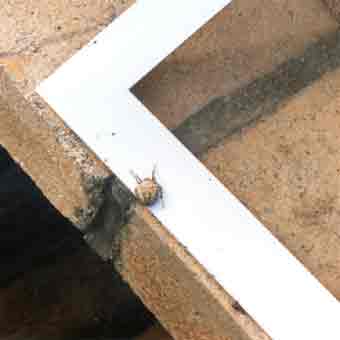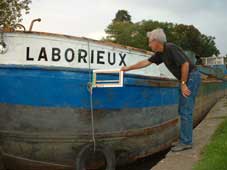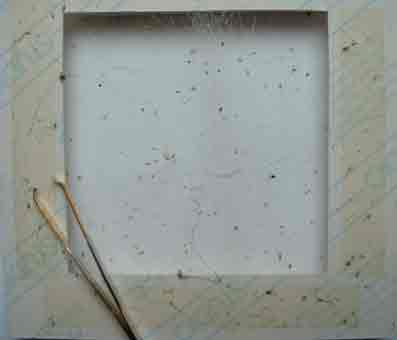When pulling off and
applying the first spider's web in open space and
putting it onto a frame one's
hands become tools and risk at every moment
ruining the stability of the
thread. These first few actions are a bit like
choreography because success
depends on supple movements, whilst at the same time
being in harmony with nature. After a certain time (try not to
measure it)
the juxtaposition of many numerous threads will reveal an astounding
and unexpected
texture. The sight of these contours, and shapes suggesting
people and objects, causes
jubilation and excites the imagination, sending
thoughts off into unknown
territory. Grateful thanks are offered to
Nature and
her little creatures, who also offers a wonderful opportunity for
creativity. The work
can possibly be summed up in a few words:
The struggle to accomplish a
good piece of art
Poetry
of the
transparent colours
The mystery of playing with texture
and gold
The patience
to struggle with
difficult subjects
Creativity with a touch
of madness.You will not find the technique described in any book, but if you
are practical and dexterous, and have a lot of patience you will have the pleasure
of discovering an astounding support for painting on. Here are some
tips which will help you
attain the magic of this form of painting.
1
- Not many tools
are used and a simple cardboard frame of the size you want
will serve as a support for the webs. To start with the size should
be small
(10cm x 10cm), and the frame covered with glue, or partially covered with double-sided sticky tape.


The work
is sometimes dangerous
If you stick your frame to the edge of a window you may be visited by a
beautiful garden spider, but
sadly she will not understand what you want, and
>> your work will not
have progressed. The best method is quite laborious, and involves
collecting, in the wild, spiders' webs, one on top of the other onthe sticky
frame. This action is repeated numerous times - you need at
least 300
webs to fill a frame of 10x10cms. These layers are like a
hand-madeweaving because the texture obtained is completely random. Tweezers
are always used to
pick out any insects or dust carried into the web by the wind.
This is rather boring and
repetitive but has to be done to obtain a
smooth surface.
 For
instance on 20 webs there are at least 50 bits to pick off.
Be
careful not to break the
first threads.
For
instance on 20 webs there are at least 50 bits to pick off.
Be
careful not to break the
first threads.
2
After checking that the
new support is completely covered by silken
threads,
you are able to start
painting, and it is possible to paint on both the
front and back with either
oil paints or acrylics. The brushes are
obviously small sizes, and
sometimes the use of tiny specks of gold leaf can bring a bit
of sparkle to the work. Often an oil glaze is used to bring out
the
subtleties of the texture of
the silk, and highlight certain areas. Too
much paint
will block out the texture of the support. Accidents easily
happen, holes
poked through the threads, and after many hours' work it is easy to get
discouraged.

 repair in
progress with gold and painting
repair in
progress with gold and painting
3
A little
varnish, and a box frame mounting and the work is finished. The
artist can wash his brushes
and listed to music of his choice.

Return
to summary
Top
of page